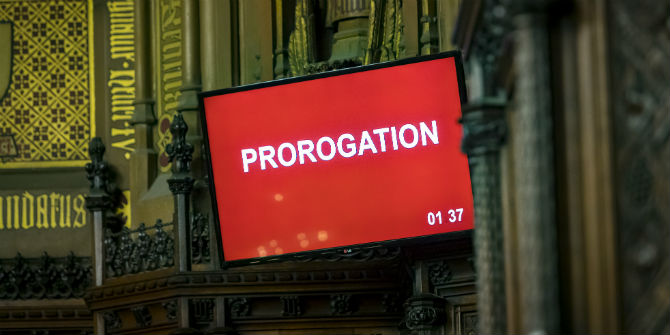 The Commons is not just split over Brexit, but split four ways – hard Brexiteers, the ‘Goldilocks’ faction, supporters of a soft Brexit and Remainers. In order to make any progress, writes Dimitri Zenghelis (LSE), at least two of the groupings must agree on something. This makes the sequencing of votes extremely important – and that is something in the Speaker’s gift.
The Commons is not just split over Brexit, but split four ways – hard Brexiteers, the ‘Goldilocks’ faction, supporters of a soft Brexit and Remainers. In order to make any progress, writes Dimitri Zenghelis (LSE), at least two of the groupings must agree on something. This makes the sequencing of votes extremely important – and that is something in the Speaker’s gift.
Labour MP Hilary Benn’s hasty last-minute withdrawal of his amendment to May’s Brexit deal highlights a key feature of the coming negotiations. Sequencing matters. Like much of the country, everyone in parliament seems to know what they’re against, but no one can quite agree on what they are for. This makes progress hard because to get anything through parliament requires a majority. But this can change. Take the following example by way of simplification.
Assume there are four broad groupings, none of which command a majority. Each would prefer the following outcome of the Brexit negotiations. The first group, let’s loosely call them ‘the ERG’, want a hard Brexit. This means no customs union; no single market membership; no Irish backstop. The second group, supported by the government, wants a ‘Goldilocks Brexit’ (not too hard, not too soft). This may involve some kind of bare bones customs union and limited or no access to the single market while retaining the ability to trade globally. Another group, call them ‘soft Brexit’, prefer membership of the customs union and possibly the single market too (perhaps a ‘Norway plus’ or EEA arrangement). This has the support of the official opposition and much of the Labour party. Finally there are those from all parties who would prefer no Brexit and would rather remain in the EU (we call them ‘remain’).

Although none of these groupings alone command a majority, it is possible that any grouping of two or more can swing the balance and break the impasse. Even though there is no majority for a particular kind of Brexit, there are potential majorities against various aspects of Brexit. And when majorities can be found to remove certain options, alliances can form. Hilary Benn withdrew his amendment, which would have rejected May’s deal and prevented a no-deal Brexit, following pressure from party colleagues just hours before last Tuesday’s crucial vote on May’s deal. This was after government whips had reportedly suggested that MPs should vote in favour of the deal to spare May a humiliating triple-figure defeat.
But there was more to Benn bowing to pressure than the risk that he might spare the government’s blushes. If the amendment had passed, it would have made it impossible for the vote on May’s deal to go ahead, but it would also have meant that the key aim of the ERG grouping would have been thwarted by Parliament. With nowhere else for them to turn, this would have potentially broken the deadlock by allowing the ERG to side with May and push for another, perhaps slightly modified, version of her plan for fear that any alternative would arrest the Article 50 process and jeopardise Brexit. May’s Brexit would have been thrown a lifeline, subject perhaps to some concessions from Brussels on the Irish backstop.
A move by parliament to rule out ‘no deal’ may yet prove to be best way to secure some kind of Brexit on the basis agreed by May and the EU. This is why despite the historic Commons defeat, we may not have seen the last of May’s deal. If, on the other hand, an early majority is found to rule out a second referendum (which is also possible), then a grouping of Remain and soft Brexiteers might form a majority in favour of a soft, Norway-plus arrangement, with the UK possibly in both the customs union and single market.
Paradoxically, this logic is borne out by May’s doomed attempt to use the threat of ‘no Brexit’ and ‘no deal’ to get her deal through the Commons. This proved counterproductive. Firstly, the threat was not credible because both outcomes cannot mutually coexist. More fundamentally, ‘no Brexit’ appeals to Remain and ‘no deal’ appeals to the ERG, so neither had good reason to support her deal on the basis of this threat. With one or other option removed, the balance shifts.
Moving forward requires at least two of the above groups to agree on something, even if that something is systematically closing off options. This may not be as easy as it sounds, as groups vie to pass only their preferred form of Brexit or as party politics starts to dominate (with the opposition less interested in reaching a deal than forcing an election by prolonging chaos, and the government less interested in passing a Brexit deal than preventing a split in the Conservative party). It is still entirely possible the paralysis endures and the question (or at least some question) is handed back to the people to break the deadlock.
Indeed, for all the posturing, a second referendum is still more palatable to the government and many MPs than inflicting economic hardship through ‘no deal’, which is why it is proving harder to rule out. After all, if you can’t reach a decision, it is always tempting to postpone it or delegate it to another authority. But for all the complexity, one underlying aspect of the negotiations remains clear. As with so many majoritarian games, the arithmetic behind hatching alliances can often be a matter of sequencing. Over to you, Mr Speaker.
This post represents the views of the author and not those of the Brexit blog, nor the LSE.






